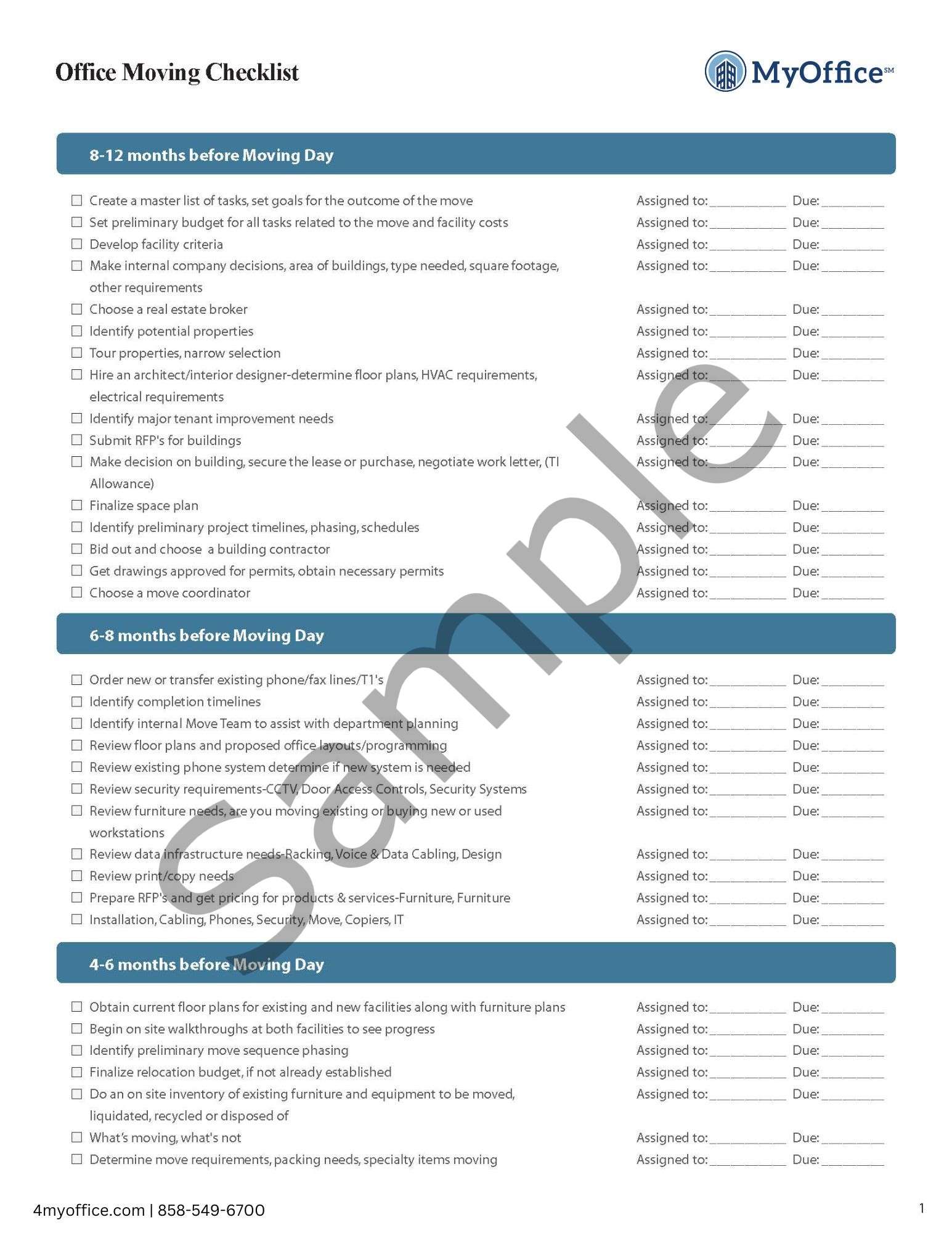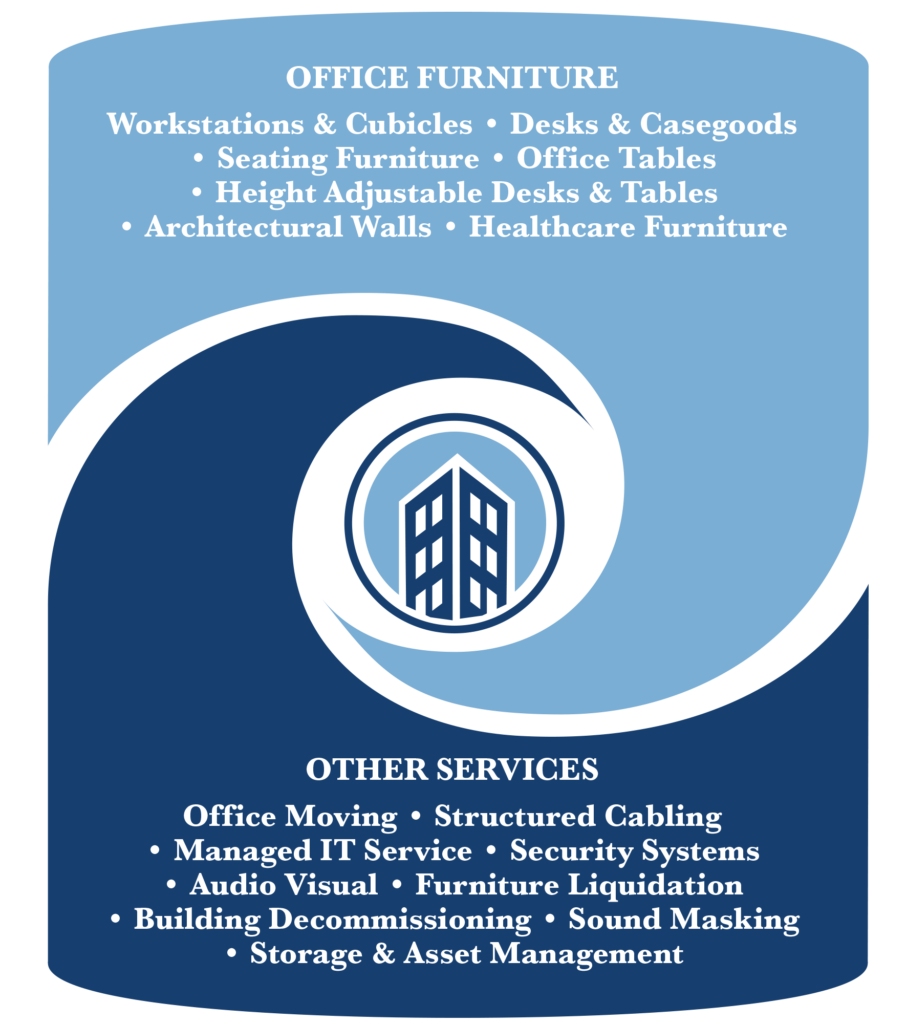22 Jul 8 Expert Tips for Successful Office Moves, Additions, and Changes
An office move, addition and change (MACs) can be a daunting task, but with proper planning and preparation, you can ensure a smooth transition to your new space. A trusted partner like MyOffice can go a long way in reducing the overall management burden on your employees as well as the stress that can occur during such an endeavor. Please consider the following 8 expert tips based upon our 20+ years of experience assisting clients with their MAC projects. This article is a bit longer than our usual content, but the information is vital for a successful MAC implementation.

Planning for a successful office move
The first step in planning for a successful office move is to create a detailed timeline. Start by identifying the date you need to be out of your current office and work backwards to determine the key milestones leading up to that date. This will help you stay organized and ensure that all necessary tasks are completed on time.
 Next, create a comprehensive checklist of all the tasks that need to be completed. This should include everything from notifying your employees and clients about the move to arranging for the transportation of office equipment and furniture. Assign responsibilities to different team members to ensure that each task is properly managed.
Next, create a comprehensive checklist of all the tasks that need to be completed. This should include everything from notifying your employees and clients about the move to arranging for the transportation of office equipment and furniture. Assign responsibilities to different team members to ensure that each task is properly managed.
Another important consideration when planning for an office move is to assess the new space and determine if any renovations or modifications need to be made (you will hear the term tenant improvement (TIs) if you are leasing a space and often is component of the leasing arrangement). This could include anything from painting the walls to installing new lighting fixtures or even moving walls. It’s important to factor in these additional costs and schedule them accordingly.
Essential considerations for office additions
 Expanding your office space through additions can be an exciting opportunity for growth, but it’s important to carefully consider several essential factors before embarking on such a project. First and foremost, you need to assess whether your current space can accommodate an addition. Consider the layout of your existing office and determine if there is enough room for expansion without compromising the functionality of the space.
Expanding your office space through additions can be an exciting opportunity for growth, but it’s important to carefully consider several essential factors before embarking on such a project. First and foremost, you need to assess whether your current space can accommodate an addition. Consider the layout of your existing office and determine if there is enough room for expansion without compromising the functionality of the space.
Additionally, you need to evaluate the impact that an office addition will have on your employees. Will they need to be relocated during the construction process? If so, how will this affect their productivity and morale? It’s important to communicate with your employees throughout the entire process and address any concerns or questions they may have.
Furthermore, it’s crucial to obtain the necessary permits and approvals from local authorities before starting any construction work. This will ensure that your office addition is in compliance with building codes and regulations. Hiring a professional architect or contractor who specializes in office additions can help streamline this process and ensure that all necessary paperwork is completed correctly.
Finally, consider the changes in furnishings that will be needed with an addition. Workstations, seating and general meeting tables and conference areas will be needed to complete the addition. Tying in technology will also be a major focus and we go into greater detail on that subject below.
Managing office changes effectively
Change is inevitable in any business, and effectively managing office changes is crucial to maintaining a productive and engaged workforce. Whether it’s a change in leadership, a shift in company culture, or a reorganization of physical spaces, it’s important to approach these changes with a clear strategy and open communication. On a side note, office changes are becoming increasingly important with remote working arrangements. Understanding your space and how best to utilize it is vital. It is estimated that inefficiently used office space is costing companies in the US $300,000+ per year.
 One key aspect of managing office changes effectively is to clearly communicate the reasons behind the change. Employees are more likely to embrace and support the change if they understand the rationale behind it. Be transparent about the goals and objectives of the change and how it will benefit both the company and the employees.
One key aspect of managing office changes effectively is to clearly communicate the reasons behind the change. Employees are more likely to embrace and support the change if they understand the rationale behind it. Be transparent about the goals and objectives of the change and how it will benefit both the company and the employees.
Additionally, it’s important to provide support and resources to employees during the transition period. This can include modifications of work schedules, temporary remote working arrangements, or access to external resources like temporary office space arrangements. By investing time and resources to assist your employees through the change on the front end, you can help them navigate the changes more successfully and ensure a smooth transition.
Furthermore, it’s crucial to involve employees in the decision-making process whenever possible. This not only empowers them and makes them feel valued, but it also ensures that the changes are implemented in a way that aligns with their needs and preferences. Consider establishing a feedback mechanism or a task force to gather input and ideas from employees.
The importance of smooth office transitions
When it comes to office transitions, whether it’s a move to a new location or a change in the layout of your existing space, the importance of a smooth transition cannot be overstated. A well-executed transition can minimize disruption to your business operations and help maintain employee productivity and morale.
One key aspect of a smooth office transition is effective communication. Keep your employees informed about the upcoming changes and provide them with the necessary support and resources to adapt to the new environment. This can include conducting training sessions on new equipment or systems, as well as addressing any concerns or questions they may have.
 Another key factor in a smooth office transition is thorough planning and organization. Create a detailed plan that outlines all the tasks that need to be completed and assign responsibilities to different team members. It’s also a good idea to create a timeline to ensure that everything is completed on schedule. This will help minimize downtime and ensure a seamless transition.
Another key factor in a smooth office transition is thorough planning and organization. Create a detailed plan that outlines all the tasks that need to be completed and assign responsibilities to different team members. It’s also a good idea to create a timeline to ensure that everything is completed on schedule. This will help minimize downtime and ensure a seamless transition.
Lastly, it’s important to evaluate the success of the transition after it has been completed. Seek feedback from your employees and address any issues or concerns that may have arisen during the process. This will help you identify areas for improvement and make future transitions even smoother.
Communicating with employees during office transitions
During office transitions, effective communication is key to keeping your employees informed, engaged, and motivated. Whether it’s a move to a new location, an office addition, or a change in the layout of the existing space, regular and transparent communication is essential to minimize confusion and address any concerns or questions that may arise.
One effective way to communicate with employees during office transitions is through regular email updates. Send out regular updates to keep employees informed about the progress of the transition, key milestones, and any changes or adjustments to the plan. Be sure to provide clear instructions and guidelines to help employees navigate the transition smoothly.
In addition to email updates, consider organizing town hall meetings or information sessions to provide employees with an opportunity to ask questions and voice their concerns. This will help ensure that everyone is on the same page and provide a forum for open and honest communication.
Technology considerations for office transitions
 In today’s digital age, technology plays a crucial role in office transitions. Whether it’s moving to a new location, adding new office space, or implementing changes to the existing setup, it’s important to carefully consider the technology requirements and ensure a seamless transition.
In today’s digital age, technology plays a crucial role in office transitions. Whether it’s moving to a new location, adding new office space, or implementing changes to the existing setup, it’s important to carefully consider the technology requirements and ensure a seamless transition.
One key consideration is the infrastructure necessary to support your technological needs. This starts with assessing the capacity of your existing network infrastructure. From there, you can evaluate the need for additional servers, switches, or other networking equipment as needed. It’s important to work closely with your IT department or an external technology consultant like MyOffice to ensure that your technology infrastructure is properly planned and implemented.
Additionally, it’s crucial to assess the compatibility of your existing systems and software with the new setup. Determine if any upgrades or modifications are necessary to ensure compatibility and seamless integration. This could include upgrading hardware, updating software versions, or even migrating to a new system altogether.
Likewise, it’s important to involve your IT department or technology partner early in the planning process. They can provide valuable insights and recommendations on the technology requirements and help identify any potential challenges or roadblocks. By involving them from the beginning, you can ensure that your technology needs are properly addressed and minimize any disruptions during the transition.
Budgeting for office moves, additions, and changes
Budgeting for office moves, additions, and changes is an important aspect of the planning process. It’s crucial to carefully consider all the costs associated with the transition and allocate the necessary funds to ensure a successful and smooth transition.
 It’s important to consider the cost of moving or adding office space. This includes everything from the actual moving or construction costs to any necessary renovations or modifications to the new space. Obtain quotes from multiple vendors or contractors to ensure that you are getting the best value for your money.
It’s important to consider the cost of moving or adding office space. This includes everything from the actual moving or construction costs to any necessary renovations or modifications to the new space. Obtain quotes from multiple vendors or contractors to ensure that you are getting the best value for your money.
Additionally, it’s important to consider the cost of technological upgrades or modifications. This could include anything from purchasing new equipment to upgrading software licenses. Work closely with your IT department or technology partner to estimate these costs and factor them into your budget.
Furthermore, don’t forget to factor in the cost of employee downtime during the transition period. While it may be impossible to completely eliminate downtime, proper planning and organization can help minimize its impact. Consider providing additional resources or support to help employees stay productive during the transition.
Finally, consider the long-term costs associated with the office changes. This could include anything from increased rent or mortgage payments to higher utility bills. Evaluate the financial impact of the changes and ensure that you have accounted for these costs in your budget.
Tips for minimizing downtime during office changes
Minimizing downtime during office changes is crucial to maintaining productivity and ensuring a smooth transition. Here are some expert tips to help you minimize downtime and keep your business running smoothly during office moves, additions, and changes.
Primarily, it’s important to create a detailed plan that outlines all the tasks that need to be completed and assign responsibilities to different team members. This will help ensure that everyone is on the same page and that all necessary tasks are completed on time. Consider creating a timeline to help you stay organized and ensure that everything is completed in a timely manner.
Additionally, it’s important to communicate with your employees and set clear expectations. Inform them about the changes that will be taking place and provide them with the necessary resources and support to adapt to the new environment. Consider conducting training sessions or workshops to help employees familiarize themselves with any new equipment or systems.
Also, it’s crucial to test all systems and equipment before implementing any changes. This will help identify any potential issues or glitches and allow you to address them before they become major problems. Consider setting up a test environment to simulate the new setup and ensure that everything is functioning properly.
Lastly, consider hiring professional help for office moves, additions, and changes. Companies like MyOffice have the experience and capabilities to handle all aspects of your office transition. From planning and organization to logistics and implementation, we have you covered. By outsourcing the process to professionals, you can focus on running your business while ensuring a smooth and successful transition.
Conclusion
In conclusion, office moves, additions, and changes can be complex and challenging, but with proper planning and execution, they can also be an opportunity for growth and improvement. By following these expert tips, you can ensure a successful and smooth transition to your new office space. Remember to communicate effectively with your employees, involve them in the decision-making process, and provide them with the necessary support and resources to adapt to the changes. And if you need professional help, trust MyOffice for your office moves, additions, and changes. With our experience and capabilities, we can help make your project a success – contact us for your MAC project success.

Making changes to your office environment can be difficult, we make it easy….
Click here to read more about MyOffice services.
